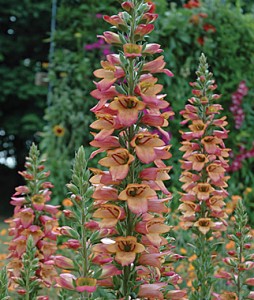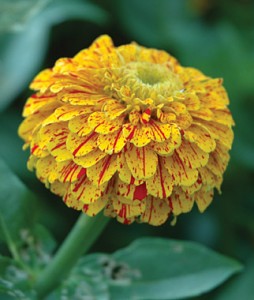New Seasonal Showstoppers
Posted in Gardening Tips on March 18 2014, by Sonia Uyterhoeven
Sonia Uyterhoeven is the NYBG’s Gardener for Public Education.

I picked up the Select Seeds catalog and stopped dead in my tracks. Facing me from the second page was a gorgeous intergeneric hybrid called ×Digiplexis ILLUMINATION® ‘Flame’. The name will make sense just as soon as I explain its heritage, and wipe away any thought of ’70s disco dancers you may be entertaining at the moment.
You have heard me use the term intergeneric hybrids before, when I have discussed orchids. Intergeneric hybrids are crosses between closely related genera. A well-known example in the orchid world is ×Laeliocattleya, which is a cross between a Laelia and a Cattleya. In the case of ×Digiplexis, it is a cross between a foxglove (Digitalis) and Isoplexis, which is a shrub-like, short-lived perennial (zone 9 – 11) from the Canary Islands and Madeira.
Isoplexis typically grows up to 4 feet tall and 3 feet wide. It has foot-long upright flower spikes that are densely covered with tubular flowers, each a blend of vermillion, rust, and gold. Its common name, cresta de gallo, alludes to the fact that it is reminiscent of a cockscomb. The plant was originally thought to have been pollinated by sunbirds, having since been replaced by Canary Island Chiffchaffs and other warblers.
Scientists have done research on this genus and found that while it is pollinated by birds, the pollination is infrequent. Isoplexis has an answer for this: the flowers stay open and ready for pollination for several months at a time. This tender perennial will be in bloom throughout the summer in your home garden (June to September or October).
Hybridize Isoplexis with foxgloves (×Digitalis) and you have a long-blooming annual that reaches about 3 feet tall. The long duration of the hybrid’s bloom isn’t due to low pollination frequency, as the hybrid is sterile and doesn’t waste its energy producing seeds.

The vermillion in the blooms is infused with violet from the marriage of the two genera, and the tubular flowers still resemble cockscombs or, if you have a good imagination, a laughing mouth. Combine Isoplexis with the hardier foxglove and you get a short-lived perennial that is hardy to zone 8. The foliage on the hybrid resembles that of the foxglove, and this showstopper is ideal for a container. To see for yourself, just visit the plants we’ll have on display at the NYBG over the coming year.
If instead you are looking for garden pizazz that’s inside your comfort zone, take a look at some of the new varieties of zinnias that are appearing in this year’s catalogs. Zinnia ‘Pop Art Golden and Red’ is showing up everywhere (Burpee, Select Seeds, Jung Seed, etc.). This golden zinnia looks like it has been splattered with red paint. Its fully double painted blooms have the elegance and authority of a 17th-century Dutch still life. This zinnia is also disease resistant and easy to grow.
For more choices, look for Zinnia ‘Pop Art White and Red’ (Select Seeds) and Zinnia ‘Tudor’ (Park Seed, Jung Seed). ‘Pop Art White and Red’ is like its sibling described above, reaching around 2 feet tall, while ‘Tudor’, with its solid, purple-magenta, fully double flowers grows 2 1/2 – 3 feet tall. All of them make excellent cut flowers and are a breeze to grow from seed.
All photos courtesy of Burpee


xDigiplexis sounds like some new kind of glass to me, but what a fabulous looking plant! Do you know who did the plant breeding to create it? And when intergeneric hybrid names are created, is there is any rule about which genus goes first?